After a scintillating
Day 1 and
Day 2 at INTEGRATE 2017, the stage was perfectly set for the last (Day 3) day of the event. Before you proceed further, we recommend you to take a read at the following links –
Quick Links
Session 1 – Rethinking Integration by Nino Crudele
Day 3 at INTEGRATE 2017 started off with the “Brad Pitt of the Integration Community” – Nino Crudele. It was a perfect start to the last day of this premier integration focused conference.
Nino started off his session by thanking his mentor, a fellow MVP for instilling knowledge about Power BI. This session was based on true experience. Nino shared his experience of how he calls the job as his passion with three different types of jobs – Bizzy (BizTalk), DEFCON1, and Chicken Way. In this context, what Nino refers to the Chicken way is the way in which you can actually solve the problem – you can take a direct or an indirect approach to solve the problem.
Nino even had some Chicken Way Red Cards to give away to the community and some reactions to that were –
Then Nino presented the most comical slide of the entire #Integrate2017 event – a question / answer from his 12-year old daughter about BizTalk.
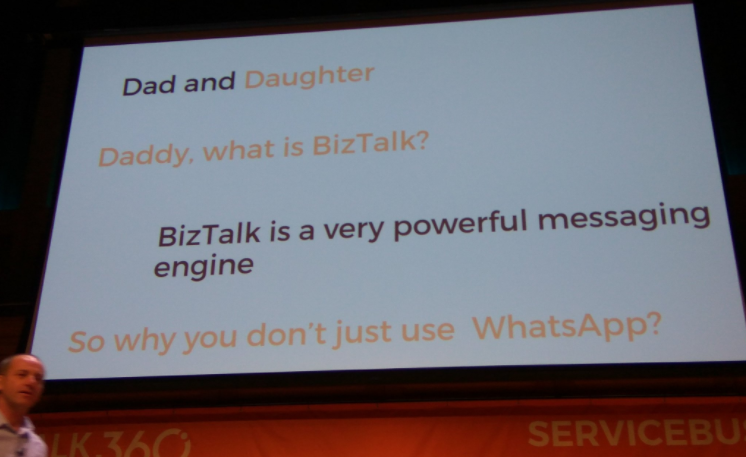
The above slide shows how people perceive the technology actually. Therefore, it’s imperative that you have to choose the proper technology to solve the specific problem and make the customer happy. Nino also explained what according to him are the top technology stacks and made a mention that “BizTalk is SOLID” – a very solid technology platform.
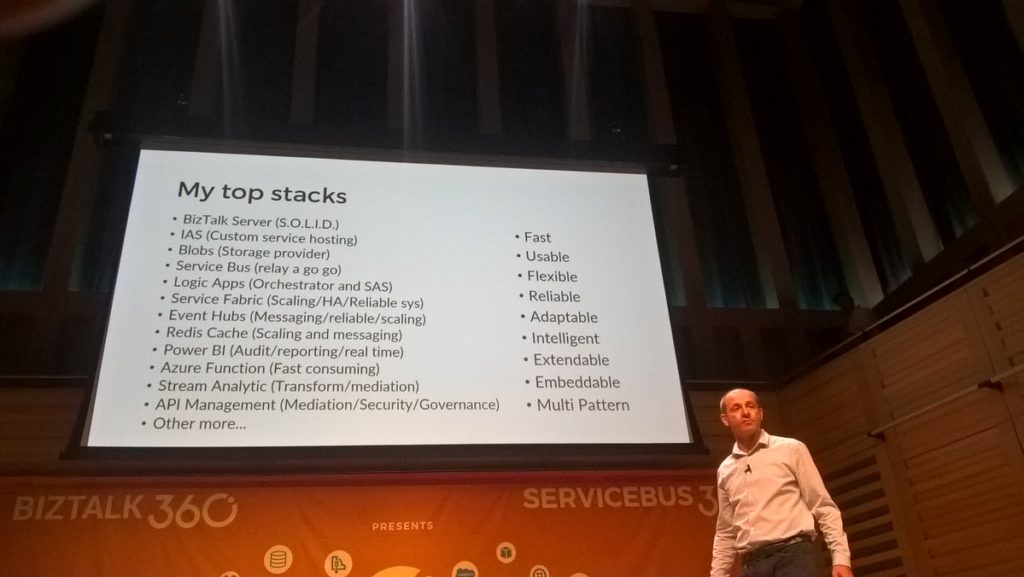
Then Nino gave an example of his customer experience where the customers were using 15 BizTalk Servers! :O Nino suggested changes to certain approaches in their business process, and the way to get the real time performance improvement. The customer was also looking for a real fast hybrid integration (point to point) with BizTalk in the project with real time monitoring, tracing and so on. Nino suggested a framework that was completely built over the cloud. This approach was more reliable and the customer had complete control over the messaging system, scalable and so on. The solution made use of Logic App, Event Hubs, Service Bus, Blob storage and many more such integration solutions which made the customer happy.
The session moved into a cool demo from Nino (real time data visualization in Power BI using custom visualization) which you can get to watch when the videos go Live on the INTEGRATE 2017 website.
Session 2 – Moving to Cloud-Native Integration by Richard Seroter
The second session of the day was from Richard Seroter on Moving to Cloud-Native Integration. Richard started off his talk with the analogy of “theory of constraints” where processes are limited to throughput by the constraint (bottleneck). In any software environment, you have to focus on what is the constraint that is slowing you down and optimize it. In an organization environment, there are chances that the “integration might itself be the constraint” to slow things and slow down the business.
Therefore, Richard introduces the concept of cloud native integration to connect different systems.
Integration Today
According to Gartner, in current scenario, application-to-application integration is the most critical integration scenario, while few years down the line, cloud service integration will rise to the top. The actual spending on integration platforms is on the rise with the fastest growth in iPaaS and API Management.
Again, Gartner says, by 2020, 75% of the companies will establish a hybrid integration platform using an infrastructure that they assemble from different vendors. By 2021, atleast 50% of large companies will have incorporated citizen integrator capabilities into their integration infrastructure.
What is Cloud Native?
Cloud native is basically “how” do I build a software!
The following image clearly shows the difference between a traditional enterprise and a cloud native enterprise.
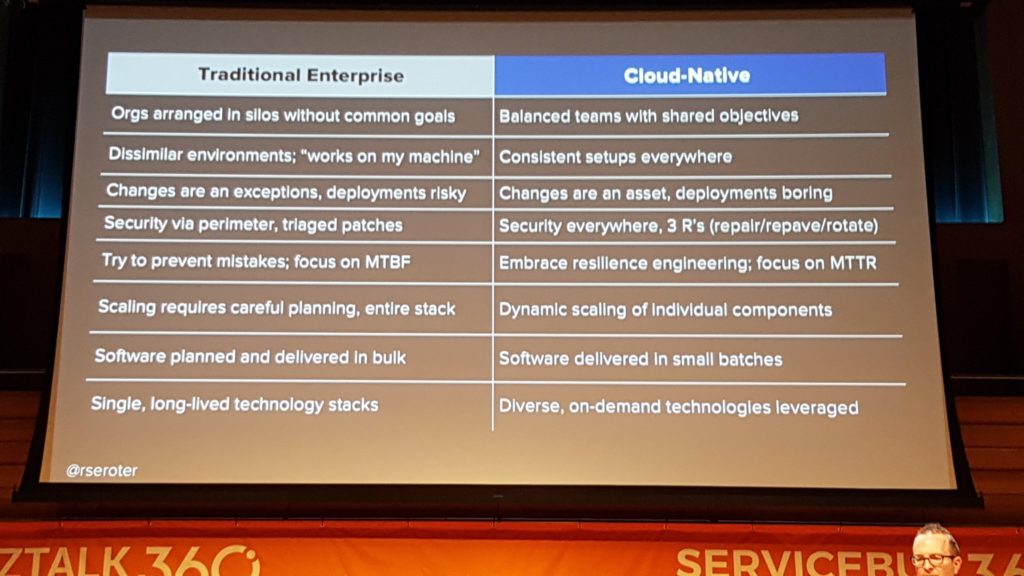
Delivering Cloud Native Integration
- Build a more composable solution that is
- Loosely coupled
- Makes use of choreographed services
- Push more logic to the endpoints
- Offer targeted updates
Richard then jumped into his demos where in the first demo, he used a Logic App as a data pipeline. The Logic App receives a message from the queue, call a service running in Azure App service, call a Azure function that does some fraud processing, and feed the result message back to the queue for further processing.
To feed the queue, Richard deploys another Logic App where a file is picked up from OneDrive, parse the file as a JSON array and dump it to the queue which is on the other Logic App.
That’s not it! Richard had few more demos in store – Making BizTalk server easy where he used BizTalk 2016 FP1 Management APIs to create BizTalk artifacts self-service style, and automate Azure via Service Broker.
We recommend you to watch this session when the video is made available in a week’s time on the INTEGRATE 2017 website.
Session 3 – Overcoming Challenges When Taking Your Logic App into Production
Stephen started off with a key announcement about the readiness of a New Pluralsight Course – “
BizTalk Server Administration with BizTalk360“. The course will be made available shortly.
Phase 1 of the session was targeted towards ‘
Decision Making‘, phase 2 was on what we did right and wrong, and the last phase with some important tips.
Decisions
Stephen compared building a .NET parser solution to Logic Apps development. Logic Apps was calculated to have finished earlier and way cheaper. They even questioned if Integration Account are worth the price ($1000 per month)
What’s Wrong and Right?
-
- Make design decisions based on the rules on the serverless platform and factoring costs per Logic Apps action
- Stephen described that initially he used 2 subscriptions in 2 regions, but this made deployment across regions hard. Therefore, the best practice is to have one subscription in one region
- Solution structure – Solution level maps to a resource group, use one project per Logic App, maintained 3 parameter files, one per environment. For performing deployment you can create a custom VM.
- Serverless – is AMAZING, but sometimes things break for no fault of your own, sometimes Microsoft support needs to be called in for support/fixing issues
Tips
- Read the available documentation
- Don’t be afraid for JSON – code view is still needed especially with new features, but most of the time are soon available in designer and visual studio. Always save or check-in before switching to JSON.
- Make sure to fully configure your actions, otherwise you cannot save the Logic App
- Ensure name of action, hard to change afterward
- Try to use only one MS account
- If you get odd deployment results, close / reopen your browser
- Connections – Live at resource group level. The last deployment wins. Best practices: define all connection parameters in one Logic App. One connection per destination, per resource group.
- Default retries – all actions retry 4 additional times over 20s intervals.
- Control using retry policies
- Resource Group artefacts – contain subscription id, use parameters instead
- For each loop – limited to 100000 loops. default to multiple concurrent loops, can be changed to sequential loops
- Recurrence – singleton
- User permissions (IAM) – multiple roles exist like the Logic App Contributor, and the Logic App Operator
With that, it was time for the attendees to take a break!
After the break, Duncan Barker from the BizTalk360 team took the stage to thank the wonderful team at BizTalk360 for all their effort in making INTEGRATE 2017 a great success!

Session 4 – BizTalk Server Deep Dive into Feature Pack 1
Tord was given a warm welcome with the song “Rise” by Katy Perry. Tord complimented the welcome by saying how good friends he and Katy Perry are and the story behind how she wrote the song for BizTalk. 🙂
Fun aside, Tord started off the session by saying how BizTalk Server 2016 almost got a pink theme for the icons! :O Just hours before the team was to do the final build for
BizTalk Server 2016 Feature Pack 1 release, one of the engineers pointed out the pink stroke on the outside of all icons. The team managed to fix and ship the release.
But, do you know! There is
one tiny pixel of pink somewhere in some icon? If you find it, send Tord an email and he will send you a nice gift!
BizTalk Connector in Logic Apps is now Generally Available with Full Support!!!
Microsoft IT team have built a first class project to help migrate easily to BizTalk Server 2016. You can get your downloadable version of the application from the below link. If migration is what is holding you, then make use of this application.
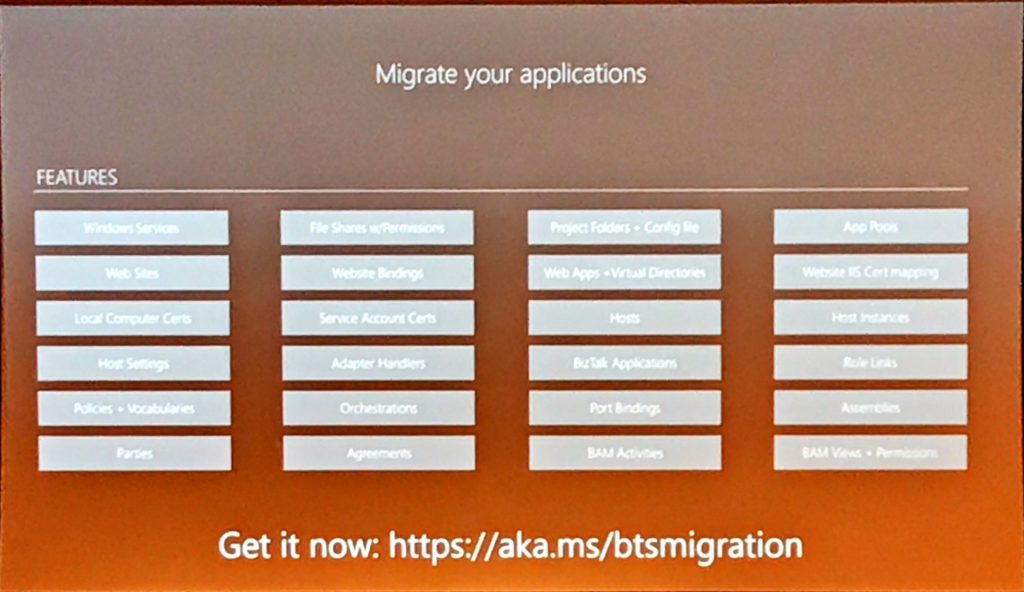
With BizTalk Server, you can do so many things! You can take advantage of the cloud through BizTalk Server. Tord walked through the different features that were released as a part of Feature Pack 1 in detail with some Live Demo.
Session 5 – BizTalk Server Fast & Loud
After that power packed introduction from Daniel Szweda for Sandro Pereira comparing him with Cristiano Ronaldo (who as well hails from Portugal), guess what happened! SANDRO PEREIRA forgot to Turn on his machine to show his presentation :O The IT admin guy at Kings Place almost had to show up 5 – 6 times to get the “problem” solved, and Sandro termed it with the famous word “Jetlag” that was associated with most speakers during any technical issues 😛 🙂 And.. there was a roar when the presentation worked for Sandro! Phew … There goes the BizTalk Wiki Ninja, BizTalk Mapper Man, The Stencil Guy into his session.
Sandro started off his session with this slide
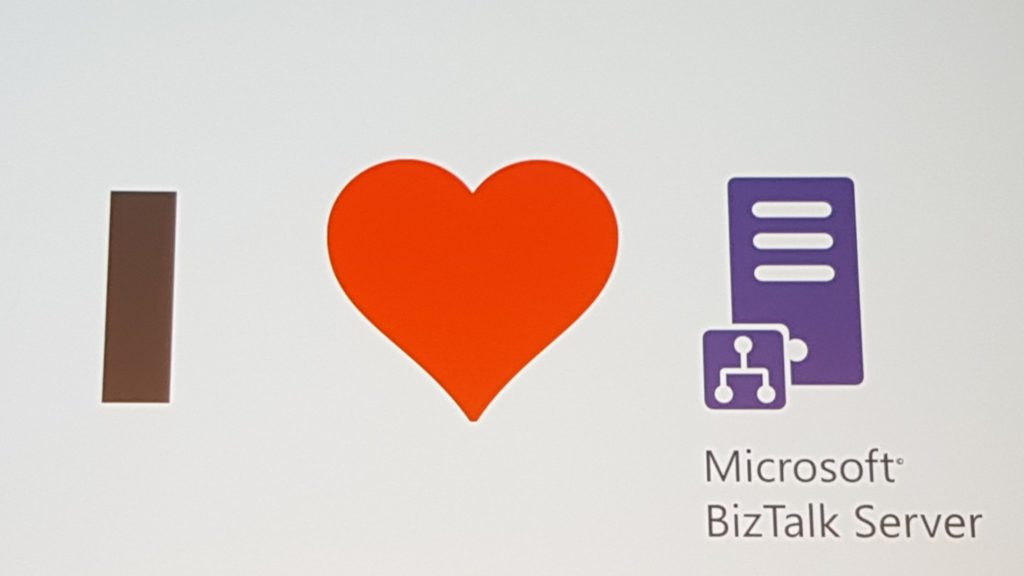
Sandro’s session was more towards BizTalk Server optimization and performance. The points discussed in this session were –
SQL Server
- Clients still don’t have BizTalk Jobs running
- Comparing in a Car terminology,
- BizTalk Server is the Chassis
- SQL Server is the Engine
- Hard Drivers is the Tiers
- Memory is the Battery
- CPU is the Fuel Injector
- Network and Visualization Layer is the Exhaust pipe
- Make sure BizTalk Server and SQL Server Agent jobs are configured and running
- Treat BizTalk databases as a Black box
- Size really matters in BizTalk! Large databases impact performance (Eg., MessageBoxDB, Tracking database)
- Consider dedicating SQL resources to BizTalk Server
- Consider splitting the TempDB into multiple data files for better performance
Networking
- Speed defines everything for this layer
- At a minimum, you need to have 1 logical disk for data files, 1 for transaction log files, and 1 for TempDB data files
- Remove unnecessary network
- Scaling out is not a solution to all problems – sometimes you may also have to scale in to solve a problem!
Session 6 – BizTalk Health Check – What and How?
The last session before lunch was on BizTalk Health Check – What and How? by Saffieldin Ali. BizTalk Health Check is something similar to the MOT Testing that’s performed on vehicles in UK. MOT Testing is a compulsory test for exhaust and emissions of motor vehicles.
In BizTalk, the health check is performed to –
- Identify symptoms and potential problems before it affects production environment
- Review critical processes to achieve minimum downtime due to disaster recovery
- Identify any warnings and red flags that may be affecting users
- Understanding of common mistakes made by administrators and developers
- Understand the supportability and best practices
BizTalk Health Check Process
Interviewing
- Operations Interview (1-1 meetings with admins/dev teams to collect operational view of things)
- Knowledge Transfer
Collecting
- Run collection tools (BizTalk Health Monitor etc)
- Collect informal information (say, I did something wrong last week during an informal discussion)
Analysis and Reporting
- Run and examine analysis tools results
- Write and Present final conclusion
BizTalk Health Check Areas
- Platform configuration for BizTalk Server
- BizTalk Server Configuration
- BizTalk Performance
- Resilience (High Availability)
- SQL Server Configuration for BizTalk Server
- Disaster Recovery
- Security
- BizTalk Application Management and Monitoring
BizTalk Health Check Key Tools
- Microsoft Baseline Security Analyser (MBSA)
- BizTalk Best Practices Analyser
- BizTalk Health Monitor (BHM)
- Perf Analysis of Logs (PAL)
Safieldin showed how each of the above products work and how they perform the checks on the BizTalk environment.
It was time for the community to break out for Lunch and some networking before the close of the event in the next couple of hours.
Session 7 – The Hitchhiker’s Guide to Hybrid Connectivity by Dan Toomey
The last leg of #Integrate2017 was something quite significant. All the 3 speakers – Daniel Toomey, Wagner Silveira and Martin Abbott are the ones who have flown into London after some long flights. Dan and Martin from Australia (about 20 hours) and Wagner from New Zealand (about 30 hours!).
Post lunch, it was time for Dan Toomey from Australia to take the stage to talk about The Hitchhiker’s Guide to Hybrid Connectivity.
Dan started his talk about the types of Azure Virtual Network –
- Point to Site (P2S) – Something similar to connection when you work from home and connect to corporate network (connect to Citrix/VPN) over the internet
- Site to Site (S2S) – taking an entire network and joining with another network over the internet
- ExpressRoute – something like taking a giant cable (managed by someone else) and connecting your corporate network on that.
VNET Integration for Web/Mobile Apps
- Requires Standard and Premium App Service Plan
- VNET must be in the same subscription as App Service Plan
- Must have Point to Site enabled
- Must have Dynamic Routing Gateway
VNET with API Management
If you have API Management that is sitting in your Virtual Network with access to your Corporate Network gateway, you will get:
- Added layer of security
- All benefits of API Management (caching, policies, protocol translation [SOAP to REST], Analytics, etc)
Non-Network based Operations
Azure Relay (an alternate approach) – This is a new offering with Azure Service Bus
-
- WCF Relay
- Relies on the WCF Framework
- Hybrid Connections
- Operates at transport level
On-Premises Data Gateway
- Generally available since 4th May 2017
- Acts as a bridge between Azure PaaS and on-prem resources
- Works with connectors for Azure Logic Apps, Power Apps, Flow and Power BI
Daniel wrapped up his talk by talking about the following business scenarios –
- Azure Web/Mobile App to On-Prem
- IaaS Server (VM) to On-Prem
- SaaS Service to On-Prem
- Business to Business
- Service Fabric Cluster to On-Prem
To know more about these scenarios that Dan talked about, please watch the video which will be made available soon.
Session 8 – Unlocking Azure Hybrid Integration with BizTalk Server by Wagner Silveira
In this session, Wagner started off his talk speaking about Why BizTalk + Azure, and what BizTalk brings to Hybrid Integration –
- On-premises adapters
- Azure adapters
- Separation of concerns
- Availability
- For existing users
- Leverage investment into the platform
- Continuity to developers
Wagner talked about the ways in which you can connect to Azure in detail along with some scenarios-
- Service Bus
- Azure WCF Relay
- App Services/API Management
- Logic Apps
Wagner showed an exciting demo for 2 Line of Business (LoB) systems and finally some tweets coming out of Logic Apps.
Session 9 – From Zero to App in 45 minutes (using PowerApps + Flow) by Martin Abbott
There we were! The last session at #Integrate2017. Obviously not a good feeling being the speaker as you would be closing what was an amazing 3 days of learning and experience. But Martin did a great job in showing the power of PowerApps and Flows and showed how you can build an application in 45 minutes using the combo.
Martin started off his talk talking about Business Application Platform Innovation which is represented in a very nice diagram.
Martin just had 3 slides and it was an action packed session with demo to create an application in under 45 minutes. We recommend you to watch the video which will be available shortly on the event website.
Key Announcement – Global Integration Bootcamp 2018
Martin was one of the organizers of the recently concluded Global Integration Bootcamp event in March 2017. It’s now official that we will have the #GIB event in 2018. The event will happen on
24th March, 2018. You can follow the website
http://www.globalintegrationbootcamp.com/ for further updates.
Sentiment Analysis on #Integrate2017
In the Day 1 Recap blog, we had shown some statistics on the sentiment analysis of tweets for hashtag #Integrate2017. Here is one last look at the report at 00:00 (GMT+0530) on June 29, 2017.
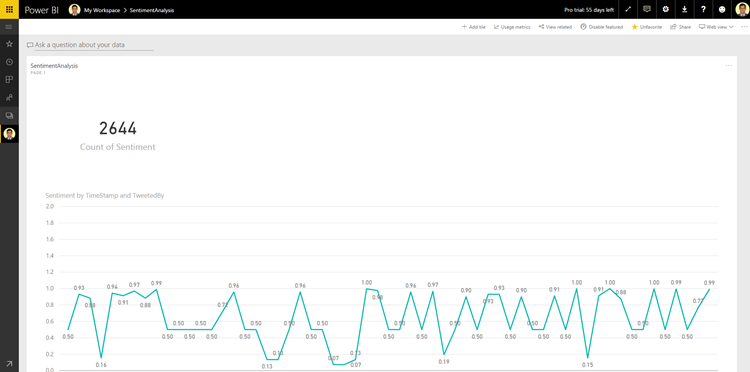
And, with that!!! It was curtains down on what has been a fantastic 3 days at INTEGRATE 2017. Well, we are not just done yet! As announced on Day 1 by Saravana Kumar,
INTEGRATE 2017 will be back in Redmond, Seattle, USA on October 25-27, 2017. So if you missed attending this event in London, come and join us at Redmond.
We hope you had a great time at INTEGRATE 2017. Until next time, adios!!!
In case you missed it!

 The above slide shows how people perceive the technology actually. Therefore, it’s imperative that you have to choose the proper technology to solve the specific problem and make the customer happy. Nino also explained what according to him are the top technology stacks and made a mention that “BizTalk is SOLID” – a very solid technology platform.
The above slide shows how people perceive the technology actually. Therefore, it’s imperative that you have to choose the proper technology to solve the specific problem and make the customer happy. Nino also explained what according to him are the top technology stacks and made a mention that “BizTalk is SOLID” – a very solid technology platform.
 Then Nino gave an example of his customer experience where the customers were using 15 BizTalk Servers! :O Nino suggested changes to certain approaches in their business process, and the way to get the real time performance improvement. The customer was also looking for a real fast hybrid integration (point to point) with BizTalk in the project with real time monitoring, tracing and so on. Nino suggested a framework that was completely built over the cloud. This approach was more reliable and the customer had complete control over the messaging system, scalable and so on. The solution made use of Logic App, Event Hubs, Service Bus, Blob storage and many more such integration solutions which made the customer happy.
The session moved into a cool demo from Nino (real time data visualization in Power BI using custom visualization) which you can get to watch when the videos go Live on the INTEGRATE 2017 website.
Then Nino gave an example of his customer experience where the customers were using 15 BizTalk Servers! :O Nino suggested changes to certain approaches in their business process, and the way to get the real time performance improvement. The customer was also looking for a real fast hybrid integration (point to point) with BizTalk in the project with real time monitoring, tracing and so on. Nino suggested a framework that was completely built over the cloud. This approach was more reliable and the customer had complete control over the messaging system, scalable and so on. The solution made use of Logic App, Event Hubs, Service Bus, Blob storage and many more such integration solutions which made the customer happy.
The session moved into a cool demo from Nino (real time data visualization in Power BI using custom visualization) which you can get to watch when the videos go Live on the INTEGRATE 2017 website.


 With BizTalk Server, you can do so many things! You can take advantage of the cloud through BizTalk Server. Tord walked through the different features that were released as a part of Feature Pack 1 in detail with some Live Demo.
With BizTalk Server, you can do so many things! You can take advantage of the cloud through BizTalk Server. Tord walked through the different features that were released as a part of Feature Pack 1 in detail with some Live Demo.
 Sandro’s session was more towards BizTalk Server optimization and performance. The points discussed in this session were –
SQL Server
Sandro’s session was more towards BizTalk Server optimization and performance. The points discussed in this session were –
SQL Server
 And, with that!!! It was curtains down on what has been a fantastic 3 days at INTEGRATE 2017. Well, we are not just done yet! As announced on Day 1 by Saravana Kumar, INTEGRATE 2017 will be back in Redmond, Seattle, USA on October 25-27, 2017. So if you missed attending this event in London, come and join us at Redmond.
We hope you had a great time at INTEGRATE 2017. Until next time, adios!!!
And, with that!!! It was curtains down on what has been a fantastic 3 days at INTEGRATE 2017. Well, we are not just done yet! As announced on Day 1 by Saravana Kumar, INTEGRATE 2017 will be back in Redmond, Seattle, USA on October 25-27, 2017. So if you missed attending this event in London, come and join us at Redmond.
We hope you had a great time at INTEGRATE 2017. Until next time, adios!!!